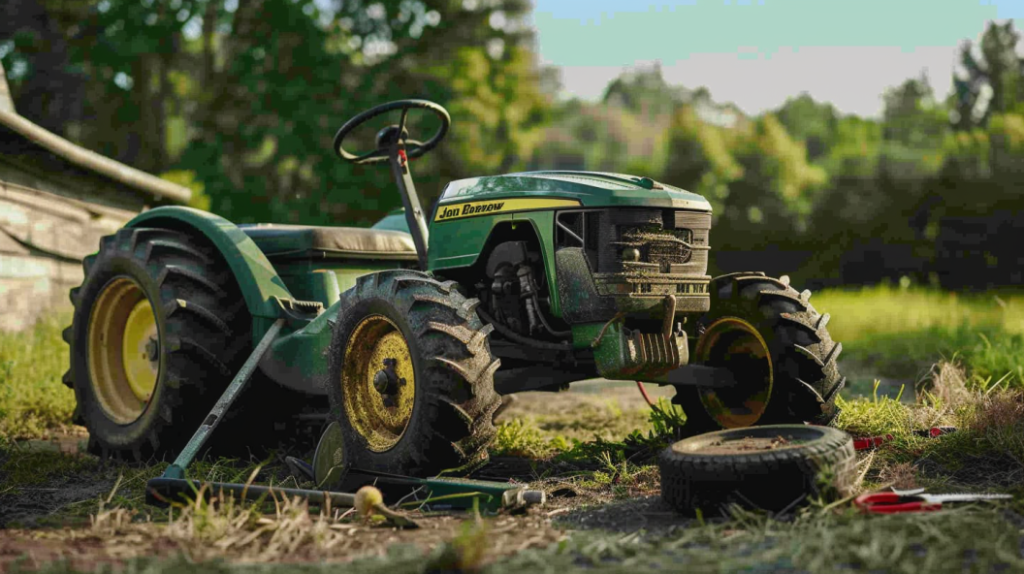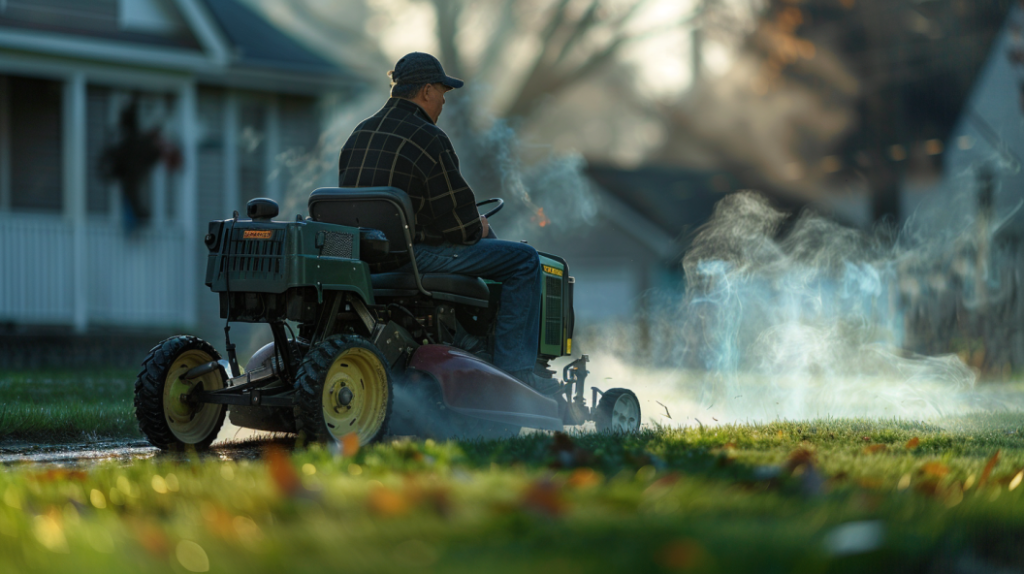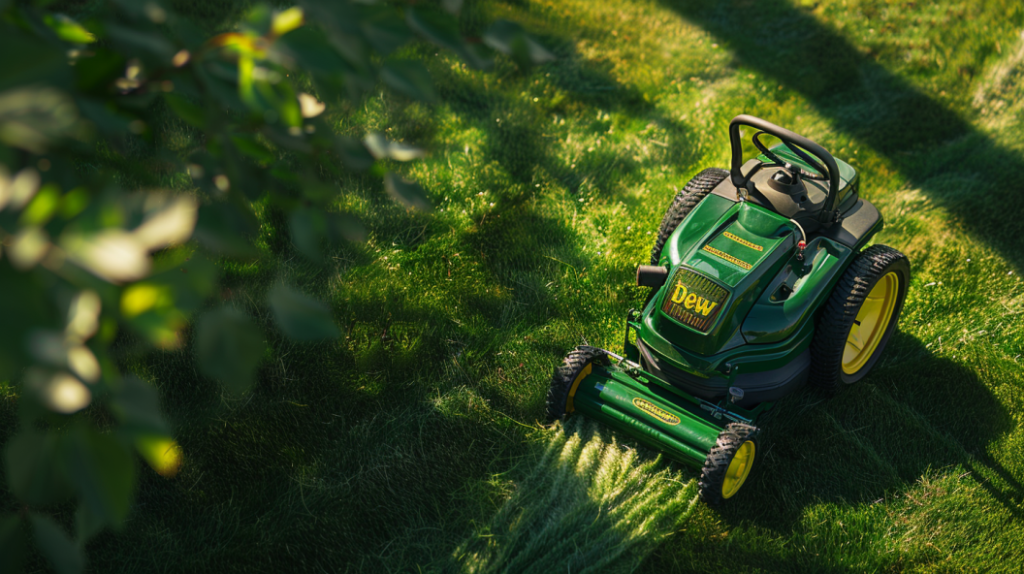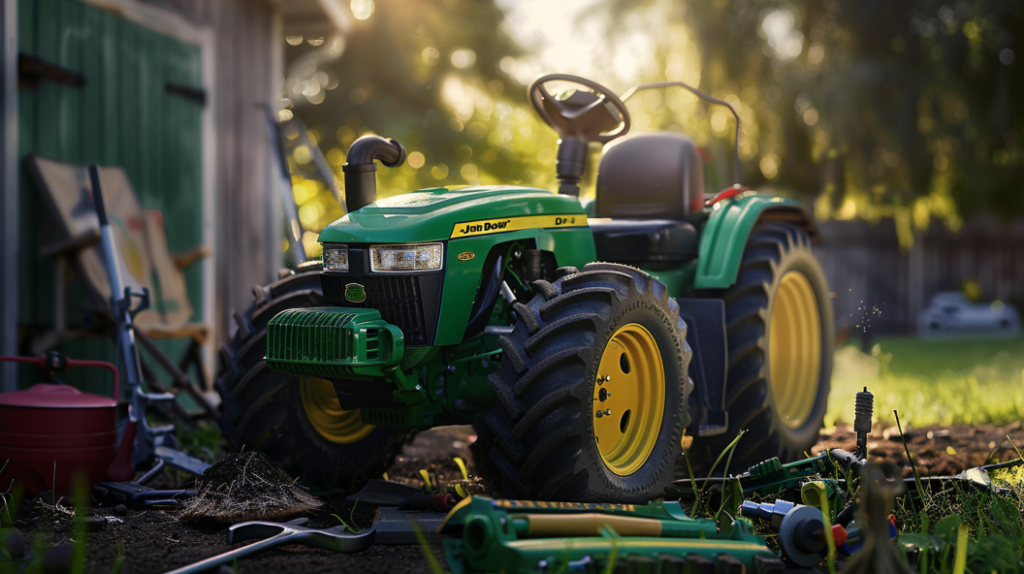If you’ve ever found yourself frustrated by unexpected hiccups with your John Deere D130, you’re not alone. From starting woes to steering glitches, this trusty machine can sometimes throw a wrench in your plans. But fear not, as there are practical fixes to these common issues that can have you back in the driver’s seat in no time. So, before you hit the lawn again, let’s uncover some solutions that might just save the day.
Key Takeaways
- Check hydraulic system for unresponsive steering or lifting issues.
- Look for hydraulic fluid leaks and address promptly.
- Address slow or jerky steering problems.
- Investigate unusual noises during operation.
- Ensure consistent lifting/lowering of attachments.
Engine Issues

If your John Deere D130 is experiencing engine issues, it may be due to a faulty ignition system. The ignition system is essential for starting and running your mower. One common problem with the ignition system is a defective spark plug. A worn-out spark plug can cause issues with starting the engine or result in poor performance. To address this, you should regularly inspect and replace the spark plug as part of your maintenance routine.
Another potential cause of engine issues in your John Deere D130 could be a clogged air filter. A dirty air filter can restrict airflow to the engine, leading to a decrease in performance and efficiency. It’s recommended to check and clean or replace the air filter if necessary to ensure optimal engine operation.
In addition to these common issues, it’s essential to keep up with regular maintenance tasks such as oil changes, fuel filter replacements, and overall engine tune-ups to prevent potential engine problems in your John Deere D130.
Starting Problems

If your John Deere D130 is experiencing starting problems, consider checking the battery for any issues.
Next, perform a thorough inspection of the fuel system to guarantee proper operation.
Battery Issues Troubleshooting
To troubleshoot starting problems related to battery issues on your John Deere D130, begin by checking the battery connections for any signs of corrosion or looseness. Corrosion can disrupt the flow of electricity from the battery to the engine, leading to starting issues. Make sure the battery terminals are tightly secured and free of any build-up. If corrosion is present, gently clean the terminals using a mixture of baking soda and water to dissolve the corrosion.
Next, inspect the battery itself. A weak or old battery may struggle to provide enough power to start the engine. Test the battery voltage using a multimeter; a healthy battery should read around 12.6 volts. If your battery is below this level to a notable extent, consider replacing it with a new one.
Additionally, check for any frayed or damaged cables connected to the battery. Faulty cables can impede the flow of electricity and cause starting problems. Replace any damaged cables to ensure a strong connection.
Fuel System Check
When diagnosing starting problems on your John Deere D130, the first step is to conduct a thorough check of the fuel system. Ensuring that the fuel system is in prime condition is essential for the engine to start smoothly.
Here are some key aspects to examine in the fuel system:
- Fuel Level: Check that there’s an adequate amount of fuel in the tank. Low fuel levels can cause starting issues.
- Fuel Quality: Confirm the fuel is fresh and clean. Contaminated or old fuel can clog the system.
- Fuel Filter: Inspect the fuel filter for any blockages. A clogged filter can restrict fuel flow to the engine.
- Fuel Lines: Check the fuel lines for any signs of leaks or damage. Leaking fuel lines can lead to starting problems.
- Fuel Pump: Test the fuel pump to confirm it’s functioning correctly. A faulty fuel pump can prevent fuel from reaching the engine efficiently.
Starter Motor Inspection

Inspecting the starter motor is crucial when troubleshooting starting problems on your John Deere D130. Start by visually examining the motor for any signs of physical damage or corrosion. Verify all connections to the starter motor are secure and free of debris. Check the wiring harness for any fraying or loose connections that may impede the flow of electricity to the motor.
Next, use a multimeter to test the voltage at the starter motor when attempting to start the engine. A healthy starter motor should receive the proper voltage to engage and turn the engine over. If the voltage is insufficient or nonexistent, it may indicate a faulty ignition switch, solenoid, or wiring issue that requires further inspection.
Additionally, listen for any unusual sounds coming from the starter motor when starting the engine. Grinding or clicking noises could signal a worn-out motor or faulty gear engagement. In such cases, replacing the starter motor may be necessary to resolve the starting problems on your John Deere D130.
Belt Slipping
If you’re experiencing belt slipping on your John Deere D130, the first step is to verify the belt tension adjustment. Verify that the belt is properly tensioned to prevent slipping during operation.
Additionally, inspect the pulley alignment to make sure it’s correctly aligned, as misalignment can also cause the belt to slip.

Belt Tension Adjustment
To prevent belt slipping on your John Deere D130, make sure proper belt tension adjustment is maintained at all times. Here are some key points to keep in mind for effective belt tension adjustment:
- Check Tension Regularly: Inspect the belt tension frequently to make certain it’s within the manufacturer’s recommended range.
- Use Correct Tools: Utilize the appropriate tools, such as a belt tension gauge, to accurately measure and adjust the tension.
- Adjust According to Manual: Refer to the John Deere D130 manual for specific instructions on how to adjust the belt tension correctly.
- Avoid Over-Tightening: Over-tightening the belt can lead to premature wear and tear on the belt and pulleys.
- Seek Professional Help: If you’re unsure about adjusting the belt tension yourself, seek assistance from a qualified technician to prevent causing further damage.
Maintaining effective belt tension adjustment is essential in preventing belt slipping issues and ensuring the smooth operation of your John Deere D130.
Pulley Alignment Check
Check the alignment of the pulleys on your John Deere D130 to address any belt slipping issues effectively. Proper pulley alignment is essential to make sure that the belt functions correctly without slipping, which can lead to inefficiencies in the mower’s operation. To perform a pulley alignment check, follow these steps:
| Steps to Check Pulley Alignment |
|---|
| Step 1: Park the mower on a flat, level surface. |
| Step 2: Inspect the pulleys for any visible misalignment. |
| Step 3: Use a straight edge to check alignment between pulleys. |
Ensuring that the pulleys are accurately aligned will help prevent belt slipping and maintain excellent performance of your John Deere D130 lawn mower. By following these steps, you can identify and rectify any misalignment issues promptly, allowing your mower to operate smoothly during use. Keep your equipment in top condition by conducting regular checks and maintenance to avoid potential problems in the future.
Uneven Cutting
Investigate cutting with the John Deere D130 lawn mower may be caused by inconsistencies in blade height adjustment. When your lawn appears patchy and unkempt after mowing, it’s time to explore the root causes of this issue.
Here are some technical insights to help you achieve a uniform and pristine cut:
- Check Blade Sharpness: Dull blades can tear grass instead of cleanly cutting it.
- Inspect Tire Pressure: Uneven tire pressure can lead to an uneven mowing height.
- Verify Blade Balance: Imbalanced blades can cause uneven cutting patterns.
- Adjust Deck Level: Make sure the mower deck is level to the ground for consistent cutting.
- Clean Undercarriage: Debris buildup can obstruct the blades, resulting in uneven cutting.
Hydraulic System Faults
Examining the hydraulic system of your John Deere D130 lawn mower is essential to identify and address any potential faults efficiently. The hydraulic system is vital for the proper functioning of your mower, as it controls the steering and lifting mechanisms. If you encounter issues with the hydraulic system, it can greatly impact the performance of your lawn mower. Here are some common hydraulic system faults you may encounter and their possible fixes:
| Hydraulic System Faults | Possible Fixes |
|---|---|
| Unresponsive steering | Check hydraulic fluid levels and top up if low. Inspect for leaks in the system. Bleed the hydraulic system if needed. |
| Slow or jerky steering | Replace the hydraulic filter. Check for any obstructions in the system. Ensure proper tire pressure. |
| Inconsistent lifting/lowering of attachments | Inspect hydraulic hoses for damage. Check the hydraulic pump for any issues. Adjust the lift linkage if necessary. |
| Hydraulic fluid leaks | Tighten any loose fittings. Replace damaged hoses or seals. Clean up any spilled fluid promptly. |
| Strange noises during operation | Check hydraulic fluid levels. Inspect the hydraulic pump for damage. Lubricate any moving parts as needed. |
Deck Problems
Examining the deck of your John Deere D130 lawn mower is essential to identify and address any potential issues affecting its cutting performance. The deck is a critical component that directly impacts the quality of your lawn mowing experience.
Here are some common deck problems you may encounter:
- Uneven Cutting: Uneven deck height or blade wear can result in an inconsistent cut across your lawn, leaving some areas longer than others.
- Deck Belt Wear: A worn-out deck belt can lead to poor blade engagement, affecting cutting efficiency.
- Clogged Deck: Grass clippings and debris can accumulate under the deck, obstructing the blades and diminishing cutting performance.
- Rust and Corrosion: Corrosion on the deck can weaken its structure and lead to holes, impacting cutting precision.
- Misaligned Deck: A misaligned deck can cause scalping or missed spots during mowing, requiring adjustment for the best cutting results.
Regularly inspecting and maintaining your mower deck will ensure a smooth and efficient mowing operation, giving you the freedom to enjoy a well-manicured lawn.
Maintenance Tips
Inspecting and maintaining your John Deere D130 mower deck regularly is essential to ensuring excellent cutting performance and longevity. To keep your mower in prime condition, start by checking the blades for sharpness and balance. Dull or unbalanced blades can lead to uneven cuts and strain on the engine.
Next, inspect the deck for any signs of wear or damage, such as cracks or rust, and address these issues promptly to prevent further deterioration.
Regularly clean the underside of the deck to remove buildup of grass clippings, dirt, and debris that can impede cutting efficiency. Pay close attention to the belt that drives the blades, ensuring it’s properly tensioned and free of wear.
Lubricate moving parts, such as pulleys and spindles, to reduce friction and prolong their lifespan.
Lastly, follow the manufacturer’s guidelines for oil changes, filter replacements, and other routine maintenance tasks to keep your John Deere D130 mower running smoothly. By staying on top of these maintenance tasks, you can maximize the performance and durability of your equipment.
Frequently Asked Questions
Can the John Deere D130 Be Used on Hilly Terrain?
Yes, the John Deere D130 can be used on hilly terrain. Its design features, such as a sturdy frame and powerful engine, make it suitable for handling varying landscapes.
When operating on slopes, make sure to take proper safety precautions like using the mower in a slow and controlled manner to maintain stability. Regular maintenance checks on the mower will also help ensure peak performance on hilly terrain.
How Often Should the Air Filter Be Replaced?
You should replace the air filter in your John Deere D130 every 100 hours of use to guarantee peak engine performance.
Neglecting this maintenance task can lead to reduced airflow, poor fuel efficiency, and potential engine damage.
By staying proactive with air filter replacements, you can extend the life of your mower and keep it running smoothly on hilly terrains.
Is It Normal for the Mower to Vibrate Excessively?
Excessive vibration in your mower can be a sign of various issues. Check for loose or unbalanced blades, worn-out pulleys, or a damaged drive belt.
Inspect the deck for debris buildup or a bent blade. Confirm the tires are properly inflated and the engine is securely mounted.
If the problem persists, it might be worth having a professional technician diagnose and repair the underlying cause to prevent further damage.
What Is the Recommended Tire Pressure for the D130?
To guarantee peak performance, maintain a tire pressure of 14 psi in your D130.
For example, consider mowing in uneven terrain with underinflated tires; the mower’s stability could be compromised, leading to an uneven cut.
Are There Any Common Electrical Issues to Look Out For?
When using the John Deere D130, watch out for common electrical issues. Check for loose connections or corroded wires that may disrupt the electrical system.
Make sure all wiring harnesses are securely connected, and replace any damaged components promptly.
Regularly inspect the battery and charging system to prevent any potential power issues.
Conclusion
In summary, staying on top of regular maintenance tasks on your John Deere D130 lawn tractor is crucial to avoiding common issues.
By inspecting spark plugs, adjusting belt tension, and maintaining the hydraulic system, you can prevent costly repairs down the line.
Remember, a well-oiled machine is like a well-tuned engine – it runs smoothly and efficiently.
Keep up with maintenance to keep your John Deere D130 in excellent condition.
Leave a Reply